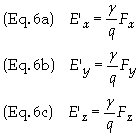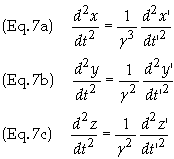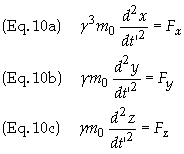
Einstein’s 1905 Error
Back
to Physics World
Back to Special Relativity
In
the famous paper On
the Electrodynamics of Moving Bodies published in 1905 in Annalen der
Physik Einstein published his ideas on relativity. This theory has come to be
known as Special Relativity meaning that it only applies to inertial
frames of reference. In this paper
Einstein derived two expressions which shows that mass depends on velocity.
These weren’t the final form of the equations and hence the masses so defined
were not the final forms that mass can take on. Einstein called these two
masses: longitudinal mass and transverse mass. While this
has been documented in the physics literature it remains a little known fact
[1,2].
In
what follows I will use Ex,
Ey
and Ez
to represent the components of the electric field in Cartesian coordinates.
Einstein uses the notation X, Y and Z for the same quantities respectively.
Later in the article Einstein uses the symbols x,
h and z
for the Cartesian components of a moving frame. I will use x’, y’
and z’ to represent these same quantities.
In
section 10 – Dynamics of the Slowly Accelerated Electron,
Einstein proceeds to derive the equations of motion for an electron with a large
velocity. He starts by examining the motion in a frame in which the electron is
instantaneously at rest at t = 0. In
this frame there is an electric field but no magnetic field. Therefore

where m0
is the
rest mass of the particle (Einstein uses the symbol m for this same
quantity). Einstein next considers the same situation from a frame, S, in
which the electron is moving in the +x direction at velocity v.
Let S’ be the rest frame of the electron. Then S’ is moving in the +x
direction with respect to S. The origins of these two frames coincide
when t and t’ equal zero. In S’ the electron is a rest
so a set of equations as that in Eq. (1) holds. Einstein then gives the
transformation equations between these two frames. They are

In S
there is both an electric and magnetic field. The transformation between S and
S’ for these fields were derived by Einstein in this paper and are given in
this section of his paper as well. They are (using MKS units)

The
force on the charged particle is given by the Lorentz force equation
![]()
In the
present case v = vex
giving

Eq. (3)
can now be written in the form

It can
be shown that the acceleration of the electron as measured in S are related to
the acceleration of the electron as measured in S’ are given by

The
equation of motion in frame S’ is

Substituting
the values for the field and the accelerations from Eqs. (5) and (7)
respectively into Eq. (8) gives upon simplification

These
are the correct equations of motion. At this step What Einstein did was to
substitute the fields from S’ back in and, after simplification, equate the
coefficients of the accelerations in S with the mass in that frame. However this
means that Einstein was mixing coordinate systems – the end result is an
error. The correct equation of motion is found by substituting Eq. (8) into Eq.
(9) to give

This can
be written as
![]()
where
![]()
If one
substitutes the components of the force from S’ then the transverse
mass would have g2
in front of the rest mass instead of g as
Einstein did.
References:
[1] Albert
Einstein's Special Theory of Relativity, Arthur Miller, pp. 328-331.
Miller explains the transverse mass error.
[2] Does mass really depend on velocity, dad? Carl G. Adler,
Am. J. Phys., 55(8), Aug 1987 page 742
It should be noted that
Einstein's original formula for transverse mass was incorrect. Planck corrected
it in 1906. Lorentz was the first to introduce the formula ![]() in 1904.
in 1904.